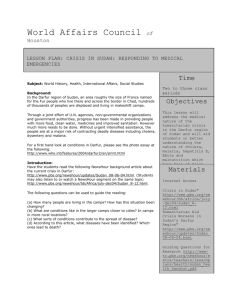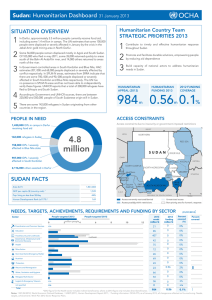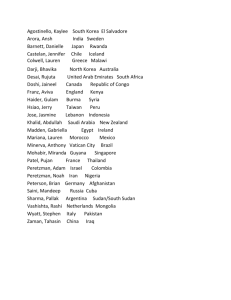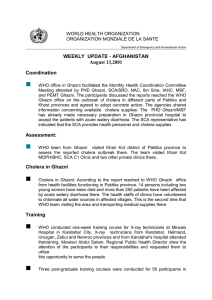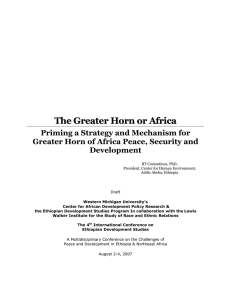SUDAN HEALTH ACTION IN CRISES RESOURCE MOBILIZATION FOR
advertisement
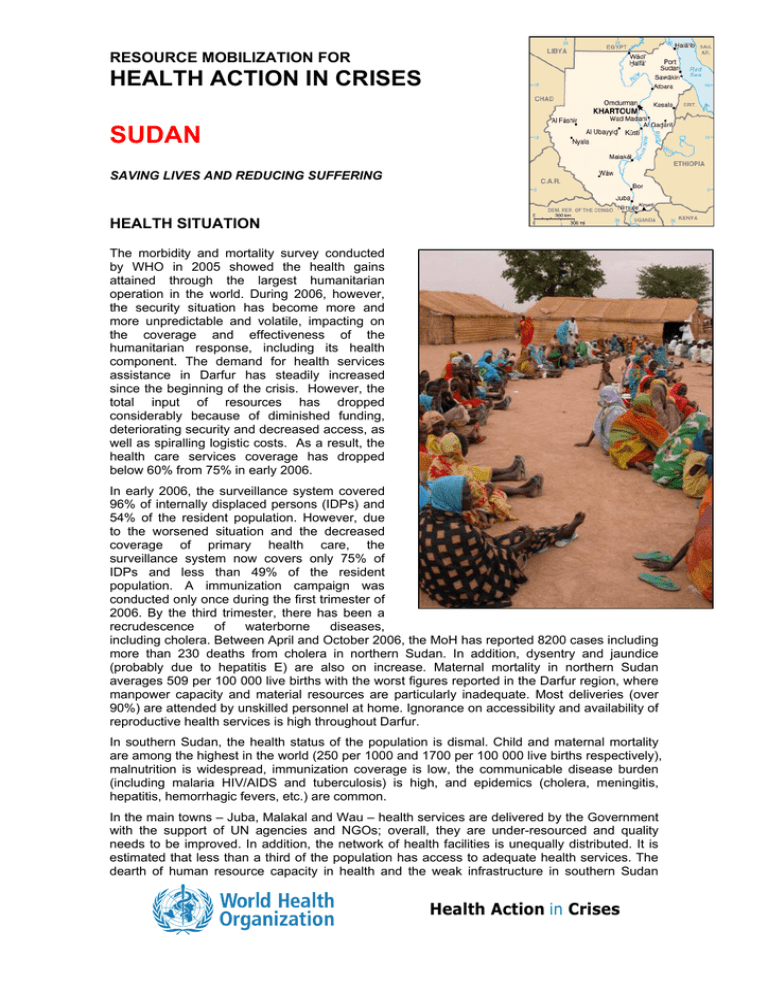
RESOURCE MOBILIZATION FOR HEALTH ACTION IN CRISES SUDAN SAVING LIVES AND REDUCING SUFFERING HEALTH SITUATION The morbidity and mortality survey conducted by WHO in 2005 showed the health gains attained through the largest humanitarian operation in the world. During 2006, however, the security situation has become more and more unpredictable and volatile, impacting on the coverage and effectiveness of the humanitarian response, including its health component. The demand for health services assistance in Darfur has steadily increased since the beginning of the crisis. However, the total input of resources has dropped considerably because of diminished funding, deteriorating security and decreased access, as well as spiralling logistic costs. As a result, the health care services coverage has dropped below 60% from 75% in early 2006. In early 2006, the surveillance system covered 96% of internally displaced persons (IDPs) and 54% of the resident population. However, due to the worsened situation and the decreased coverage of primary health care, the surveillance system now covers only 75% of IDPs and less than 49% of the resident population. A immunization campaign was conducted only once during the first trimester of 2006. By the third trimester, there has been a recrudescence of waterborne diseases, including cholera. Between April and October 2006, the MoH has reported 8200 cases including more than 230 deaths from cholera in northern Sudan. In addition, dysentry and jaundice (probably due to hepatitis E) are also on increase. Maternal mortality in northern Sudan averages 509 per 100 000 live births with the worst figures reported in the Darfur region, where manpower capacity and material resources are particularly inadequate. Most deliveries (over 90%) are attended by unskilled personnel at home. Ignorance on accessibility and availability of reproductive health services is high throughout Darfur. In southern Sudan, the health status of the population is dismal. Child and maternal mortality are among the highest in the world (250 per 1000 and 1700 per 100 000 live births respectively), malnutrition is widespread, immunization coverage is low, the communicable disease burden (including malaria HIV/AIDS and tuberculosis) is high, and epidemics (cholera, meningitis, hepatitis, hemorrhagic fevers, etc.) are common. In the main towns – Juba, Malakal and Wau – health services are delivered by the Government with the support of UN agencies and NGOs; overall, they are under-resourced and quality needs to be improved. In addition, the network of health facilities is unequally distributed. It is estimated that less than a third of the population has access to adequate health services. The dearth of human resource capacity in health and the weak infrastructure in southern Sudan Health Action in Crises affects not only service delivery; there is insufficient technical capacity for health policy and for planning the development of health systems. The shortage of key medical staff including physicians, midwifes, pharmacists and medical technicians is one of the major challenges. In the transitional areas, the health sector has been chronically under-resourced and is further hampered by the existence of two health systems, which differ in terms of modalities of health care delivery, content of services, coverage and policies/strategies. The dual system lacks consistency and coordination, which makes the provision of effective services complicated. The situation is further aggravated by significant population movements including the increasing number of returning IDPs, both from the North and the South. With limited or no capacity, a very fragile health system and a chronic lack of human resources, the transitional areas are also at risk of epidemics, especially yellow fever, meningitis and cholera. In the East, there is a continued influx of refugees and IDPs. The region’s health system is underdeveloped and lacks qualified human resources. Communicable diseases remain the leading cause of morbidity and mortality and the risk for epidemic diseases, such as meningitis, dengue fever and malaria is very high. The large presence of IDPs in Khartoum presents a unique challenge. Health assistance has been planned in way-stations, as well as in the places of displacement and arrival. However, overcrowding in the camps and settlements increases the risk of outbreaks of waterborne diseases in a community with inadequate health services. The situation has further been aggravated by a cholera outbreak and added to this is the increasing HIV/AIDS caseload, tuberculosis and malnutrition. HEALTH SECTOR PRIORITIES FOR 2007 The overall objective is to reduce avoidable morbidity and mortality among vulnerable populations in areas affected by conflict (especially Darfur) or natural disasters, to strengthen the health care delivery system and build the capacity of MoH on the federal level, in southern Sudan and in the transitional areas. ¾ ¾ ¾ ¾ ¾ ¾ ¾ Expand (in under-served geographic areas) and maintain the provision of comprehensive health care services for conflict-affected populations Strengthen the emergency preparedness response against communicable diseases Reduce maternal, newborn and child mortality and morbidity, focusing on safe motherhood, Gender-Based Violence and STIs/HIV/AIDS Strengthen national institutional and human resources capacity for policy formulation, programme design, coordination, management and health systems support Contribute to the reduction of acute malnutrition among children under five in conflictaffected and host populations Strengthen nutrition surveillance through data collection and nutrition information sharing for decision making and strategic planning Prevent and control micronutrient deficiency disorders and improve maternal and child nutrition through an integrated minimum nutrition package At the time of writing, the UN Work Plan 2007 for the Sudan was not finalized, therefore the funding requirements will be communicated separately. For more information: Ala'Din Alwan, Representative of the Director-General for Health Action in Crises, alwana@who.int Cintia Diaz-Herrera, External Relations, diazherrerac@who.int December 2006 Health Action in Crises, World Health Organization/Geneva Tel: +41 22 791 1887, Fax: +41 22 791 4844 http://www.who.int/disasters 2


